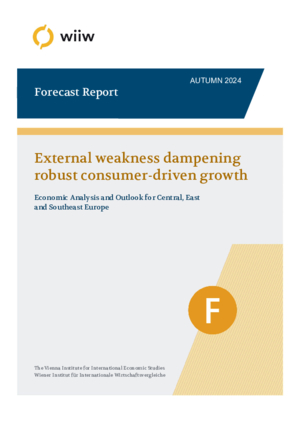External weakness dampening robust consumer-driven growth
Vasily Astrov, Alexandra Bykova, Rumen Dobrinsky, Meryem Gökten, Richard Grieveson, Doris Hanzl-Weiss, Marcus How, Gabor Hunya, Branimir Jovanović, Niko Korpar, Dzmitry Kruk, Sebastian Leitner, Isilda Mara, Olga Pindyuk, Sandor Richter, Marko Sošić, Bernd Christoph Ströhm, Maryna Tverdostup, Zuzana Zavarská and Adam Żurawski
wiiw Forecast Report No. October 2024, October 2024
158 pages including 31 Tables, 57 Figures and 3 Boxes
The current report is only available to members. Past issues become freely available online when the next report is released. Several individual sections of the report are freely available to download now (see below).
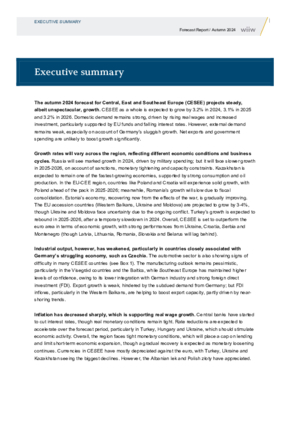
Executive summary
by Richard Grieveson
free download
Indicators 2022-2023 and Outlook 2024-2026
Premium Members only
Summary of key recent macroeconomic data for CESEE, and overview of new wiiw forecasts for 2024-2026 (Excel file)
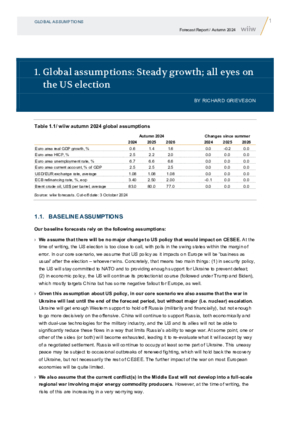
1. Global assumptions: Steady growth; all eyes on the US election
by Richard Grieveson
We assume that there will be no major change to US policy that would impact on CESEE, that the war in Ukraine will last until the end of the forecast period, that the current conflict(s) in the Middle East will not develop into a full-scale regional war involving major energy commodity producers, and that central banks will continue their monetary easing cycles. Under these conditions, the global economy should continue its steady, if underwhelming, growth during the forecast period. However, the weakness of the German economy in general, and of German industry in particular, is a serious issue for CESEE.
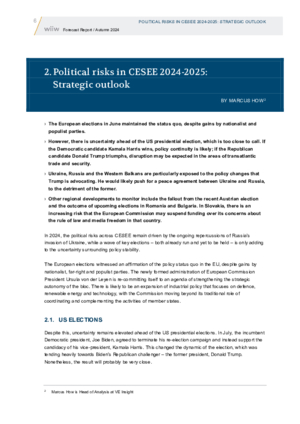
2. Political risks in CESEE 2024-2025: Strategic outlook
by Marcus How
The European elections in June maintained the status quo, despite gains by nationalist and populist parties. However, there is uncertainty ahead of the US presidential election, which is too close to call. If the Democratic candidate Kamala Harris wins, policy continuity is likely; if the Republican candidate Donald Trump triumphs, disruption may be expected in the areas of transatlantic trade and security. Ukraine, Russia and the Western Balkans are particularly exposed to the policy changes that Trump is advocating. He would likely push for a peace agreement between Ukraine and Russia, to the detriment of the former. Other regional developments to monitor include the fallout from the recent Austrian election and the outcome of upcoming elections in Romania and Bulgaria. In Slovakia, there is an increasing risk that the European Commission may suspend funding over its concerns about the rule of law and media freedom in that country.
free download
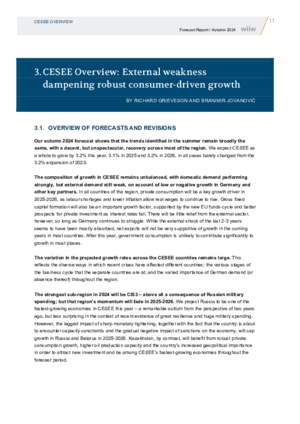
3. CESEE Overview: External weakness dampening robust consumer-driven growth
by Richard Grieveson and Branimir Jovanović
Our autumn 2024 forecast shows that the trends identified in the summer remain broadly the same, with a decent, but unspectacular, recovery across most of the region. We expect CESEE as a whole to grow by 3.2% this year, 3.1% in 2025 and 3.2% in 2026, in all cases barely changed from the 3.2% expansion of 2023. The composition of growth in CESEE remains unbalanced, with domestic demand performing strongly, but external demand still weak, on account of low or negative growth in Germany and other key partners. Our projections indicate a very solid outlook for convergence in CESEE over the forecast period. Most countries of the region will comfortably outperform the euro area both this year and in 2025-2026.
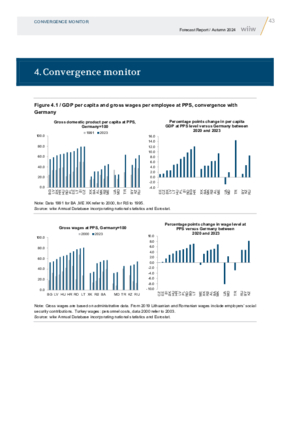
4. Convergence Monitor
by wiiw statistics department
Economic growth will strengthen in most countries of CESEE in 2025-2026, as lower inflation and interest rates boost real incomes and consumer spending. Investment should also strengthen as interest rates fall, new foreign investment arrives, and EU funds continue to be drawn down. However, the deepening crisis in German industry will continue to weigh on the export-oriented industry of CESEE. The region faces significant downside risks to growth, including a potential victory for Donald Trump in the next US election, and higher energy prices due to tensions in the Middle East.
Reference to wiiw databases: wiiw Annual Database, wiiw Monthly Database
Keywords: CESEE Central and Eastern Europe, economic forecast, Western Balkans, CIS, Ukraine, Russia, Turkey, EU, euro area, convergence, business cycle, labour markets, unemployment, Russia-Ukraine war, Russia sanctions, commodity prices, inflation, price controls, trade disruptions, Ukrainian refugees, energy crisis, gas, electricity, monetary policy, fiscal policy, impact on Austria, near-shoring, automotive industry, droughts
JEL classification: E20, E21, E22, E24, E32, E5, E62, F21, F31, H60, I18, J20, J30, O47, O52, O57, P24, P27, P33, P52
Countries covered: Albania, Austria, Belarus, Bosnia and Herzegovina, Bulgaria, Central and East Europe, CESEE, CIS, Croatia, Czechia, Estonia, Euro Area, European Union, Hungary, Kazakhstan, Kosovo, Latvia, Lithuania, Moldova, Montenegro, North Macedonia, Poland, Romania, Russia, Serbia, Slovakia, Slovenia, Southeast Europe, Turkey, Ukraine, US, Western Balkans
Research Areas: Macroeconomic Analysis and Policy, International Trade, Competitiveness and FDI
ISBN-13: 978-3-85209-080-1
Press Releases
Related News
- Autumn Forecast: Eastern Europe defies the downward drag from Germany
- Schwächere, aber immer noch positive Konjunkturimpulse aus CEE für Österreich
